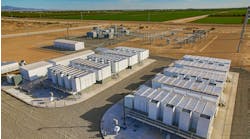Eversource Takes Local Energy Concept to New Level with New Hampshire Microgrid Plan
Eversource plans to develop an energy storage microgrid in New Hampshire that takes the local energy concept to a new level by pairing the microgrid with a bring-your-own-device program.
Charlotte Ancel, Eversource
The project also offers an example of a path for utilities to develop microgrids when state rules allow utility ownership of energy storage.
Charlotte Ancel, director of clean energy strategy, policy, and development for Eversource, unveiled the project last week at Microgrid 2019. The New England utility made a formal announcement Tuesday.
Located in Westmoreland, a rural town prone to grid disruptions, the microgrid will use a 1.7MW/7.1 MWh battery on the utility side of the meter. Eversource intends to issue a solicitation seeking contractors for the design, construction and procurement of the battery, which is expected to cost about $7 million.
The utility is designing the energy storage microgrid to improve electric reliability for 450 residential customers, local businesses, and critical facilities like the fire station, elementary school and county nursing home.
A non-wires alternative for Eversource
On the customer side of the meter, the project incorporates demand response, energy efficiency, incentives for customer-owned batteries, electric vehicle chargers, and smart thermostats. Customers choose their own brand of products to install on their premises. They receive bill credits for the energy savings their devices bring to the grid.
When demand for electricity rises, Eversource will use the customer devices to shave the peak, lessening strain on grid resources in an effort to curb price spikes.
By allowing the utility to call on the battery a couple of times per month, a customer could earn about $1,000 per year in bill credits, Ancel said. That represents about 50 percent of what the utility estimates it can save by undertaking peak shaving. The remaining cost savings would be spread among the utility’s broader customer base.
The project serves as a non-wires alternative — a use of local energy in lieu of a centralized solution. In this case, Eversource says it can avoid construction of a $6 million, 10-mile distribution circuit. The utility expects to achieve additional savings through peak shaving using customer devices.
Pathway for the energy storage microgrid
The project offers insight into a path utilities can take in developing microgrids when restructured states — those open to retail competition — allow them to own energy storage.
Restructured states generally do not let utilities own power plants. The rules were created about two decades ago, before battery storage became a viable resource, so it wasn’t considered. That leaves open to interpretation whether energy storage is a source of power or something else.
Some argue that energy storage qualifies as a power source when batteries discharge, so therefore should not be owned by utilities. Others say it’s less clear cut, given that batteries also consume energy when they charge and can play a significant role in utility energy management. Competitive companies are wary of utility ownership of energy storage, arguing that utilities could use their market clout to shut out competitors.
Two of the states where Eversource operates — Massachusetts and New Hampshire — allow utility ownership of energy storage. Connecticut, does so on a pilot basis, Ancel said. Eversource is able to develop and own microgrids using energy storage in those states.
In Massachusetts, the utility has announced two such projects, both non-wires alternatives, scheduled to begin construction at the end of this year. In Connecticut, the utility plans to unveil a project later in 2019, Ancel said.
Meanwhile, the Energy Storage Association is pushing other states to resolve issues surrounding utility ownership and who can sell services from batteries into wholesale markets.
“States seeking to maximize ratepayer benefits through innovative programs and projects must clarify ownership rules, open up regulatory frameworks to allow the same asset to provide multiple services, and enable behind-the-meter systems to receive the same opportunities as front-of-meter systems to provide grid and wholesale services,” said Kelly Speakes-Backman, CEO of the Energy Storage Association.
Speakes-Backman pointed out that Maryland as an example of a state exploring new regulatory frameworks. The state has crafted a ‘proof of regulatory concept program’ to test the benefits of creative business models that provide grid benefits, including a virtual power plant program for behind the meter resources.
Image courtesy of Eversource
State goals
Eversource, which serves about 4 million electric, natural gas and water customers in New England, is situated in a region fertile for microgrids. Its six states not only experience severe weather, but also have ambitious energy storage and greenhouse gas goals.
Massachusetts, the New England state with the largest electric load and a bellwether nationally for energy policy, wants to install 1,000 MWh of energy storage by December 31, 2025. Eversource serves electric customers in 140 Massachusetts municipalities, including Boston.
“Massachusetts has embraced energy storage as a strategic priority and its energy storage initiative has positioned Massachusetts as a national leader,” said Matt Roberts, managing director of Prospect Hill and former executive director of the Energy Storage Association.
“Building from the landmark State of Charge report, in 2017 the state set an aspirational target of procuring more than 200 MWh over the course of two years. Paired with a slew of incentives supporting a wide range of system sizes and applications, the Baker/Polito Administration is fostering a robust energy storage ecosystem and spurring innovative projects like the one Eversource is proposing,” Roberts said.
Eversource also expects the New Hampshire microgrid to reduce greenhouse gases — a benefit increasingly cited in microgrid proposals nationwide.
Greenhouse gas reduction is especially important in New England, given its participation in a mandatory carbon cap and trade program. In addition, the states have set greenhouse gas reduction goals. They are particularly stringent in Connecticut, Massachusett and Rhode Island, given that they are mandatory. Maine, New Hampshire and Vermont have aspirational goals.
More coming from Eversource
Eversource is among a growing group of utilities, including utility giants Duke Energy and Exelon, that are making a play in the microgrid space.
“We are upping our presence in this space; this organization is on board with clean energy transformation, and it’s very exciting,” Ancel said.
In Massachusetts, Eversource is looking for opportunities to provide “cost effective versions of these projects, to reduce peaks, provide grid benefits, and also to satisfy the new Clean Peaks statute,” she said.
In New Hampshire, the utility plans to build and test the first project, learn from it, and replicate it. Ancel said that energy storage microgrids especially make sense in small, rural towns with radial — not looped circuits.
“You’ll be seeing us doing a lot of this — where we’re looking to use batteries that have an extended islanding capability — to island certain circuits that are more heavily impacted by climate change,” said Ancel, who joined Eversource from Vermont’s Green Mountain Power, another utility innovating with microgrids and customer-sited batteries.
Eversource plans to seek approval of the demand response aspect of the Westmoreland program from the New Hampshire Public Utilities Commission as part of an energy efficiency filing in the second half of 2019. The 1.7 MW battery will be part of the utility’s permanent distribution rate filing submitted to the commission in late May. Project construction is scheduled to begin in late 2020, pending regulatory approval.
Track news about energy storage microgrids by subscribing to the free Microgrid Knowledge newsletter.







